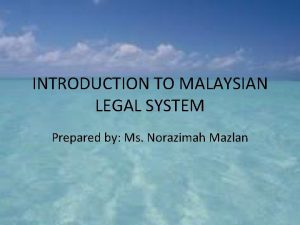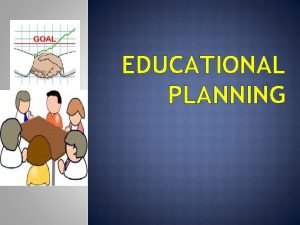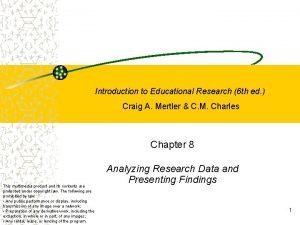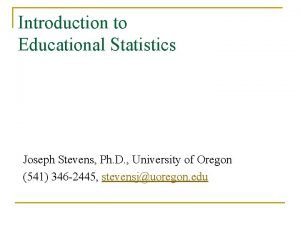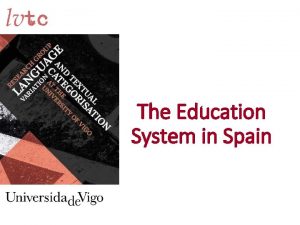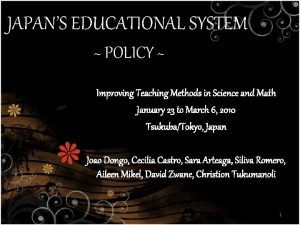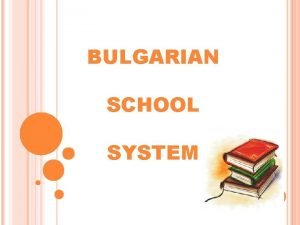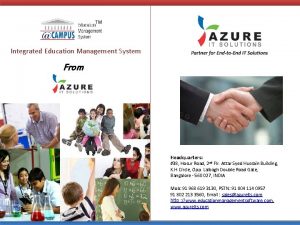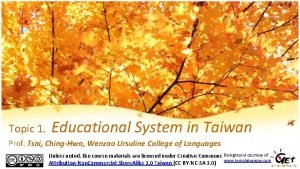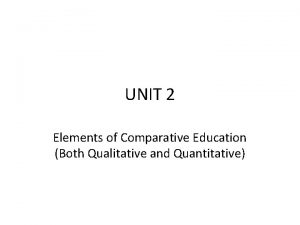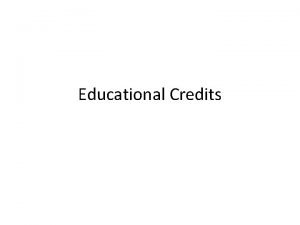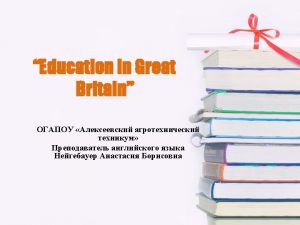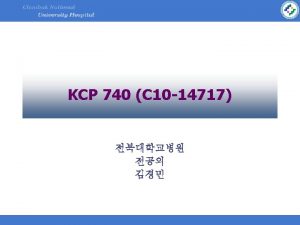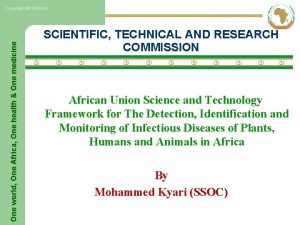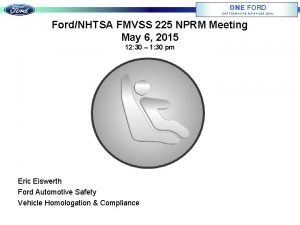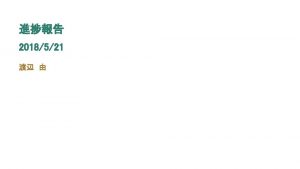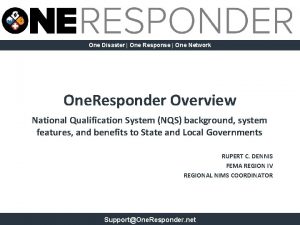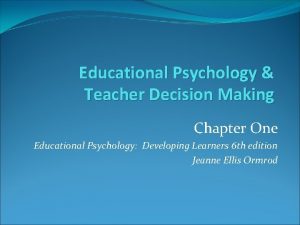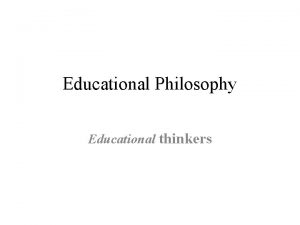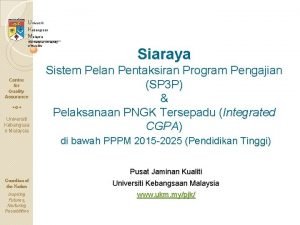Educational System in Malaysia Introduction Malaysia is one





















- Slides: 21

Educational System in Malaysia

Introduction Malaysia is one of Asia's top education destinations. The Malaysian government provides free education on primary and secondary level, summing up to an amount of 11 years for each student. Primary and secondary education in Malaysia are regulated by the Ministry of Education(MOE) whereas tertiary education is under the supervision of the Ministry of Higher Education(MOHE) There are 2 different types of government-run primary schools. As opposed to the “normal” government schools there also the so-called “vernacular” schools which have Chinese or Tamil as teaching language. Secondary school are subdivided into more or less 3 parts: national schools, religious schools and national-type Chinese or Tamil schools. Nearly all Malaysian students (compulsory in public schools) wear school uniforms which are standardized in the whole country.


Background and Ideology A decade before the end of the British rule, the educational system in Malaya was reorganized along the lines of the Barnes Report of 1951. Up to that point of time, Malaya's educational system lacked uniformity in curriculum and an articulated rationale for a policy which would be relevant to the political and socio-economic goals of the people. The country's three principal ethnic communities—Malays, Chinese and Indians (mostly Tamils from South India)—ran their own schools, the latter two often importing a syllabus used in the countries of their origin.

Literacy Rate Malaysia: Literacy rate: For that indicator, UNESCO provides data for Malaysia from 1980 to 2016. The average value for Malaysia during that period was 85. 6 percent with a minimum of 69. 52 percent in 1980 and a maximum of 93. 73 percent in 2016.

Elementary and Secondary Education in Malaysia In Malaysia, the preschool education, outside the home, begins at the age of four or five in kindergartens, which are run both by the government as well as nongovernmental agencies and the private sector. The Ministry of Education interferes the least at this level of education. It does provide broad guidelines in terms of a "curriculum, " teaching approaches and how to provide a "secure and stimulating environment" for preschool children, but it also allows considerable flexibility to the managements and teachers of such schools to make variation in the style and content of teaching. Primary education has duration of six years. Secondary education is of five years duration, which comprises of three years of lower secondary and two years of upper secondary education. It is a total of eleven years of free education. The minimum age limit for admission to the first year of primary education is seven. Primary education is compulsory for all children aged between 7 to 12 years. A common entrance examination is held at the end of primary, lower secondary and upper secondary levels.

While most of the primary and secondary schools are run by the government, there is a growing number of private schools. They are becoming increasingly popular because they give students a greater degree of mobility. At any stage, they can opt out of the private schools and join the national schools and vice versa. Such private schools use either a Malaysian syllabus or one from an overseas school. Some private schools also offer a 2 -year Sixth Form program which prepares the students for entry into local or foreign universities. The Malaysian system of education comprises four levels: primary, lower secondary, upper secondary, and postsecondary schools. Parents are free to choose the type of school, national (Bahasa Melayu) or "nationalist-type" Chinese or Tamil. Students completing six years of primary education are automatically promoted to lower secondary level.


Higher Education in Malaysia At the time of Malaya's independence in 1957, there was no university in the country. There was, however, a university in Singapore established in 1949 called the University of Malaya After the completion of secondary education, students can opt to pursue 1 to 2 years of post-secondary education. It is a preparatory course to pursue higher education at the university level. The basic entry requirement to the first year of Bachelor’s degree is the total of 12 years of primary and secondary education. Malaysian government provides 95% of the primary and secondary education and 60% of tertiary education along with the private sector. Malaysian Qualification Agency (MQA) ensures that quality education is being provided in all the public and private educational institutions.

Admission to national universities in Malaysia for undergraduate education is determined by examination and selection. Malaysia has taken several steps to bring its education in line with the developed world. It claims to have entered into "strategic alliances" between Malaysian universities and selected overseas universities known for specific areas of expertise.

Curriculum In 1983, the Ministry of Education implemented the Integrated Curriculum for Primary School, which specifies standards for each level of primary education. At Level 1 (Grades 1 to 3), the curriculum emphasizes the acquisition of reading, writing, and arithmetic skills. At Level 2 (Grades 4 to 6), the curriculum is designed to reinforce the mastery of these basic skills and build a strong foundation in science and mathematics. The science and mathematics curricula at the primary level were revised in 2011, and the revised curricula have been implemented gradually, beginning with Grade 1 students in 2011. 1 The revised mathematics curriculum is organized into four learning domains: Numbers and Operations, Measurement and Geometry, Relationships and Algebra, and Statistics and Probability. The revised primary level science curriculum is organized into six learning domains: Introduction to Science, Life Science, Physical Science, Material Science, Earth and Space Science, and Technology and Sustainable Living.

The Integrated Curriculum for Secondary School has been in effect since 1989. It encompasses a wide range of subjects in the arts and sciences, as well as vocational and technical subjects. The goal of the mathematics curriculum is to develop individuals who are able to think mathematically and who can apply mathematical knowledge effectively and responsibly in problem solving and decision making. The goal of the science curriculum is to provide students with knowledge and skills for problem solving and decision making in everyday life, guided by moral values; to prepare students to pursue further education in science and technology; and to develop a conscientious, dynamic, and progressive society with a culture of science and technology that values nature and the preservation and conservation of the environment. 2

Examination System Public Examination 1. Primary school achievement test (UPSR) at the end of six years of primary education 2. Lower secondary examination (PMR) at the end of another three years schooling 3. Malaysia certificate of education (SPM) at the end of 11 years of schooling 4. Malaysian higher school certificate examination (STPM) or the higher Malaysian certification for religious education (STAM) at the end of 13 year of schooling

Academic Calendar

Technical and Vocational Education Technical and vocational education and training (TVET) includes formal, non-formal and informal learning that prepare young people with the knowledge and skills required in the world of work. According to the United Nations Organization for Education, science and culture (UNESCO), TVET has called many names over the year-apprenticeship training, vocational education, technical vocational education, occupational education and training, workplace education and others. The common feature of TVET as defined by UNESCO is that it involves “in addition to general education, the study of technologies and related sciences as well as the acquisition of practical skills, attitudes, understanding and knowledge relating to occupations in various sectors of economics and social life” TVET programs in Malaysia are offered at certificate, diploma, and degree levels by seven ministries that include the ministry of higher education (MOHE) which offers the most TVET programs to the highest number of students

Teacher Education Teacher Training PGCE courses University of Malaya (Feb – Sep) Master of Education Nilai University ( Graduate certificates and Diplomas) 1 – 2 year Asia Metropolitan University (Graduate Certificates (9 months Diplomas) Open University Malaysia (OUM) University Utara Malaysia

Education Administration The Ministry of Education formulates the national educational policy in terms of the goals and objectives set by the Prime Minister, Minister of Education, and the Cabinet. It periodically prepares plans, programs, and projects to fit into the national Five-Year-Plans. Although the country’s constitution provides for decentralization of certain powers to the states, the federal ministry of education has throughout Malaysia’s history played a superior role in laying down polies and guideline for the state-level education departments, and at times, the district level officials in charge of education • The policy and education development sector • The education operations sector • The teacher professional development sector • The education management sector • Matriculation division • State education department • Malaysia Examination Council

Federal (Ministry of Education) (MOE) State (State Education Department)(SED) District (District Education Office)(DEO) School

Facilities for Teachers and Students Malaysian education system is very helpful in developing the country literacy rate. It is also known as one of the best country which facilitate their teachers and students in any ways. Facilities For Students High level education Equal distribution of facilities Good environment in intuition Mostly education is free of cost Good curriculum and long lasting education Library in schools Computer facility in classroom teaching Science and Computer lab in schools Comfort and Safety

Ø Facilities For Teacher The average salary for a Teacher is RM 1, 846 per month in Malaysia Many Opportunities in fast growing Flexible arrangements Good salaries package Teachers training programs Respect of job

THANK YOU!
 Malaysia malaysia malaysiansleereuters
Malaysia malaysia malaysiansleereuters One empire one god one emperor
One empire one god one emperor One one little dog run
One one little dog run One king one law one faith
One king one law one faith One empire one god one emperor
One empire one god one emperor Ford one plan
Ford one plan See one do one teach one
See one do one teach one See one, do one, teach one
See one, do one, teach one Night structure
Night structure Studiendekanat uni bonn
Studiendekanat uni bonn One vision one identity one community
One vision one identity one community Asean one vision one identity one community
Asean one vision one identity one community Introduction of educational planning
Introduction of educational planning Introduction to educational research mertler
Introduction to educational research mertler Introduction to educational statistics
Introduction to educational statistics Education system in spain
Education system in spain Japans educational system
Japans educational system Educational system in bulgaria
Educational system in bulgaria Integrated education
Integrated education Educational system in taiwan
Educational system in taiwan School system in greece
School system in greece Define the concept of comparative education
Define the concept of comparative education
